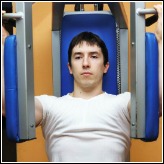5 Benefits of Plyometrics
The benefits of plyometrics exercises are numerous and each could fill a book in trying to explain the why and the how. Certainly everyone (and I mean everyone) can benefit from doing some variety of plyometric training.
From a performance perspective, the most obvious benefits of plyometrics training are that it improves the power output of sport people who utilize this training method. But there are other benefits as well…
For example, plyometrics training is said to improve:
- Greater recruitment of muscle fibers
- Explosive power
- Eccentric strength
- Co-ordination
- Decrease injury
So, let us look at some of the benefits of plyometrics in a little more depth.
Greater Recruitment of Muscle Fibers
In an untrained person, normally not all the potential motor units that can be activated in a given movement are recruited. For example, if there are 10 motor units available to the athlete in a jumping movement, under normal conditions, only 5 might be recruited to perform the movement. The limitation here is neural activation – the nervous system has to be trained to switch on.
By training the body in a plyometric way, the body makes demands on the muscular system, whose needs are met first by the nervous system. The body now learns to recruit more motor units for that specific activity or movement. With more motor units coming to your aid, this increases the force produced for that action.
Explosive Power
In performance sports the most important element is power. Power is the highest force which can be generated in the shortest time possible. In layman terms, this the speed of the muscle contraction.
So, there is a force component and a speed component to power production. However, the problem is this. It takes about 500 milliseconds under isometric conditions, for a muscle to develop maximum force. And most sports, certainly in track and field, the athlete only has at best 200 milliseconds to develop force.
So, how do you overcome this dilemma? Well, through plyometric training of course. Research has found that if a muscle is first stretched, the subsequent contraction is more powerful than if only the contraction was performed. This is known in plyometric circles as the stretch shortening cycle and the development of this element is one of the most important benefits of plyometrics training.
Your muscle is encased in connective tissue, eventually forming tendons at both ends. During the stretching part of the cycle, elastic energy is stored in this connective tissue (similar to an elastic band). As the muscle contracts (shortens) some of that elastic energy is recovered and adds to the force of the contraction. And that’s how plyometric exercises can improve your power output when time to develop force is short.
Eccentric Strength
Most explosive movements are performed by first lowering the body before the extension movement. When the body lowers, the prime mover for that movement i.e. the muscle is stretched. This stretching is called an eccentric contraction. If too much time is spent in that lowered position the energy for the subsequent movement is diminished.
Therefore the ability to control the degree of flexion in the eccentric movement before an extension is key to all explosive sports. Plyometric training loads the muscle eccentrically and over time strengthens the stabilizing muscles to lessen the degree of flexion before the subsequent extension.
Coordination
Muscle work best when they co-ordinate in sequence and time with each other. If the knee extensors activates before the hip extensors, we get a totally different movement dynamic and power output than if the hip work before the knee. Plyometric training challenges the body in many different planes. Muscles are switching on and off to gain control while still producing force.
When you first begin plyometric training you will notice moments of loss power, this is when the movement is uncoordinated. But as time is spent doing the training, these occasions become less. And thus, with improved coordination, power is born. With plyometric training the body learns to cope with these changes to produce efficient movements. The plyometric exercises themselves can be designed to cause confusion and chaos and so develop and improve agility in the athlete.
Decrease injury
In many sports the highest incidences of injury is when the joint or system is decelerating. Plyometric training not only teaches the body to produce force more effectively, it also teaches the body to control and absorb forces safely.
Reasonably recent research has found that women are two to three times more likely to suffer an ACL (anterior cruciate ligament) injury than men. Interestingly enough they also found that plyometric training is one of the best methods of protecting female sport people from this form of injury – so get to it girls.
As you can now see there are a number of fantastic benefits of plyometrics training. You have been given five here and there are many more. As with all forms of training there are dangers and so you should learn how to safely implement plyometric training before you can reap the benefits stated here.
Sign Up For The Latest Track And Field News And Improve Your Athletic Performance!
From
"5 Benefits of Plyometrics" Back To "Faster,
Stronger, Better – Your Shortcut To Improved Athletic Performance"
Learn more about plyometric training







